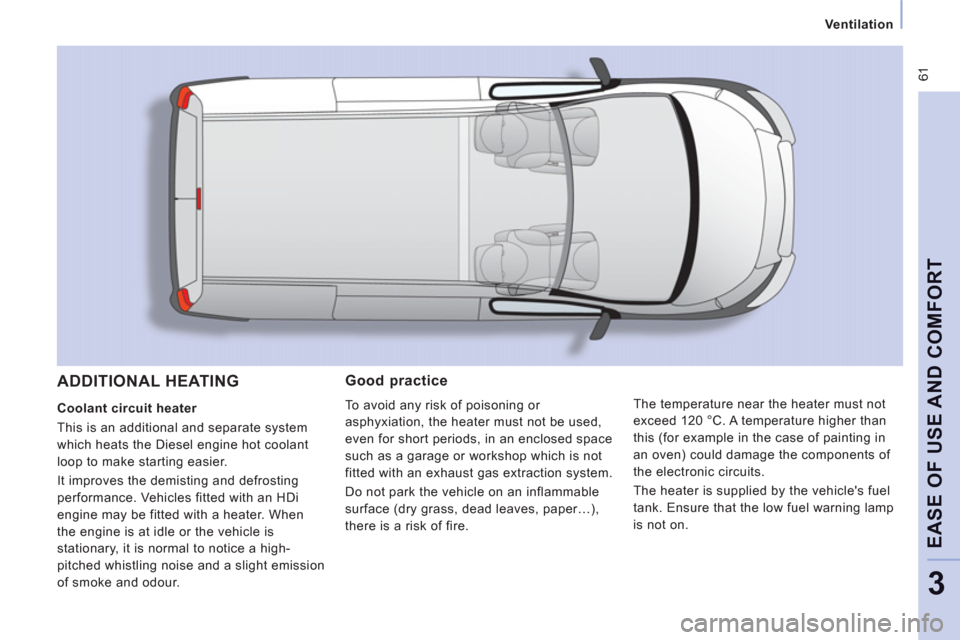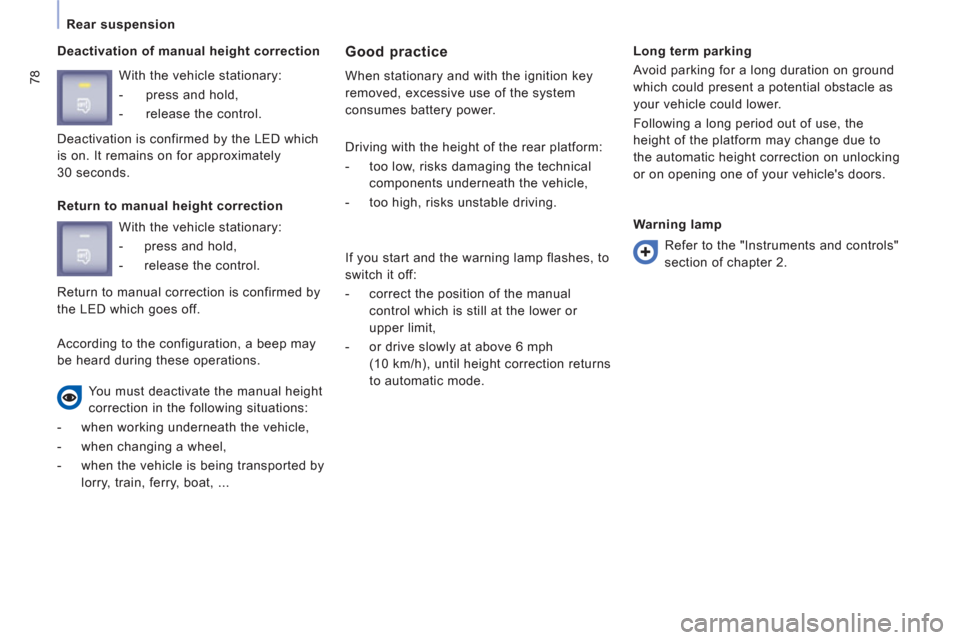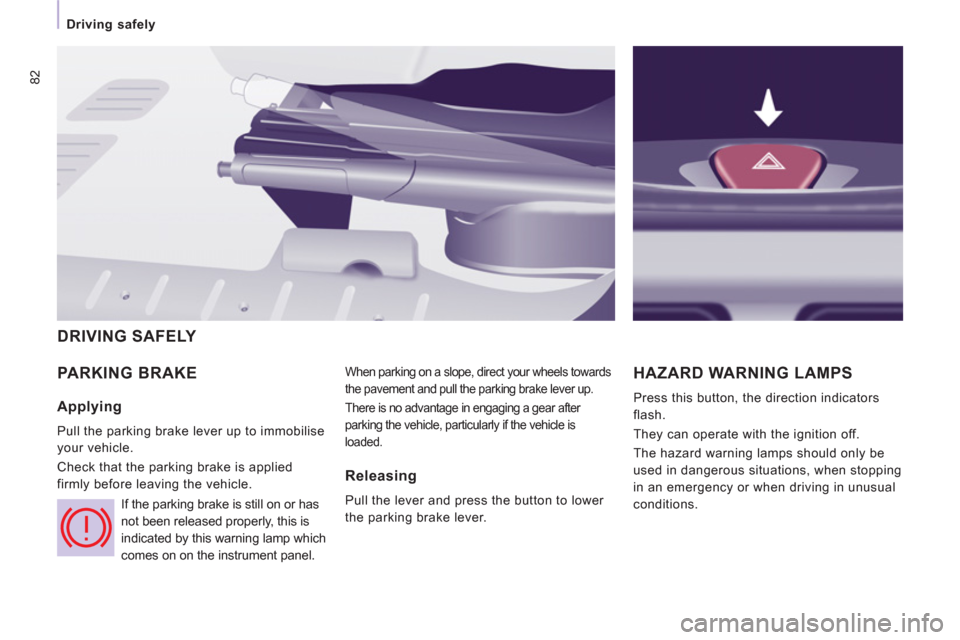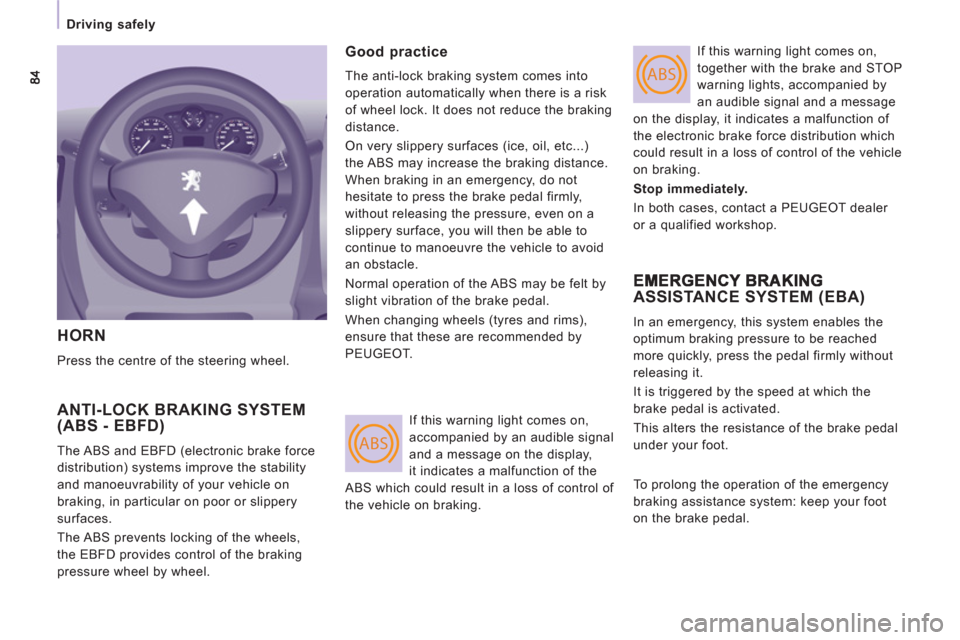2011 Peugeot Expert VU warning
[x] Cancel search: warningPage 43 of 260

41
READY to SET OFF
2
STARTING AND STOPPING
Key
Take care to prevent the key from coming
into contact with grease, dust, rain or a
damp environment.
A heavy object attached to the key (key
ring, ...) weighing the key down in the
ignition switch may cause a malfunction.
Good practice when starting
Door or bonnet open warning light
If this comes on, a door or the bonnet
is not closed correctly, check!
Diesel pre-heating warning light
If the temperature is high
enough, the warning light comes
on for less than one second, you
can start without waiting.
In cold weather, wait for this warning light to
switch off then operate the starter (Starting
position) until the engine starts.
Good practice when stopping
Minimise engine and gearbox wear
When switching off the ignition, let the
engine run for a few seconds to allow the
turbocharger (Diesel engine) to return to
idle.
Do not press the accelerator when switching
off the ignition.
There is no need to engage a gear after
parking the vehicle.
Running and accessories position.
To unlock the steering, turn the steering
wheel gently while turning the key, without
forcing. In this position, certain accessories
can be used.
Starting position.
The starter is operated, the engine turns
over, release the key.
STOP position:
steering lock.
The ignition is off. Turn the steering wheel
until the steering locks. Remove the key.
STEERING WHEEL HEIGHT ANDDEPTH ADJUSTMENT
When the vehicle is stationary, unlock the
steering wheel by lowering the lever.
Adjust the height and depth of the steering
wheel, then lock by pushing the lever fully
upwards.
Starting and stopping
Boîtes de vitesses et volant
Page 45 of 260

43
Steering mounted controls
EASE OF USE AND COMFOR
T
3
Front fog lights (green)
and rear fo
g lights (amber,
2nd rotation o
f the ring
forwards).
To switch o
ff the front and rear fog
lights, turn the ring rearwards twice in
succession.
In clear weather or in rain, both day
and night, rear fog lights dazzle and
are prohibited.
Do not for
get to switch them off when they
are no longer needed.
Automatic switchin
g on of the lights switches
o
ff the rear fog lamps, but the front fog
lamps remain on.
Daytime lights
Depending on the country in which the
vehicle is sold, the vehicle ma
y be equipped
w
ith daytime lights. The dipped headlamps
come on when the vehicle is started.
Th
e instruments and controls
(instrument panel, display, air
conditioning control panel, ...) are only lit
on switchin
g to the automatic switching on
of the li
ghts mode or when the lights are
switched on manually.
Front and rear fog lights
Rotate ring Bforwards to switch on and
rearwards to switch off. The status is
confirmed by the light on the instrument
panel.
These operate with the side lights and the
di
pped beam headlamps.
Front
fog lights (green, 1st
rotation of the ring forwards).
This warning light comes on on
the instrument panel.
Page 46 of 260

44
Steering mounted controls
Automatic illumination of headlamps
Activation
Turn the ring to the
AUTOposition.
Th
e activation of this function is
accompanied by a message in the screen.
If the sunshine sensor does not function
correctly, the lighting comes on accompanied
by the service warning lamp, an audible signal
and a message in the screen.
Contact a PEUGEOT dealer or a qualified
workshop.
HEADLAMP BEAM
Depending on the load in your vehicle,
the beam settin
g must be adjusted.
0 -
N
o load.
1 -
Partial load.
2-
Average load.
3 -
Maximum authorised load.
Do not cover the sunshine sensor
located on the windscreen, behind
th
e mirror. It is used for the automatic
illumination of headlamps and for
the automatic rain sensitive wipers.The sidelam
ps and dipped
beam headlamps switch
on automaticall
y if the light
is poor, or durin
g operation
of the windscreen wipers. The
y switch off as
soon as the light becomes bright enough or
the windscreen wi
pers stop.
This
function is not compatible with the
da
ytime running lamps.
Deactivation
Turn the ring
forwards or rearwards. The
deactivation of this function is accom
panied
by a message on the display.
The function is deactivated temporaril
y when
you use the manual lights stalk.
Initial settin
g is position 0.
In foggy weather or in snow, the
sunshine sensor may detect sufficient
light. As a consequence, the lighting will not
come on automatically. If necessary, you
must switch on the dipped beam headlamps
manually.
Page 63 of 260

61
Ventilation
EASE OF USE AND COMFOR
T
3
Good practice
To avoid any risk of poisoning or
asphyxiation, the heater must not be used,
even
for short periods, in an enclosed space
such as a garage or workshop which is not
fitted with an exhaust
gas extraction system.
Do not park the vehicle on an inflammable
surface (dry grass, dead leaves, paper…),
th
ere is a risk of fire. The temperature near the heater must not
exceed 120 °C. A temperature higher than
this
(for example in the case of painting in
an oven
) could damage the components of
th
e electronic circuits.
The heater is supplied b
y the vehicle's fuel
tank. Ensure that the low
fuel warning lamp
i
s not on.
ADDITIONAL HEATING
Coolant circuit heater
This is an additional and separate s
ystem
which heats the Diesel en
gine hot coolant
loop to make starting easier.
It improves the demistin
g and defrosting
performance. Vehicles fitted with an HDi
engine may be fitted with a heater. When
t
he engine is at idle or the vehicle is
stationary, it is normal to notice a high-
pitched whistling noise and a slight emission
of smoke and odour.
Page 78 of 260

76
Rear suspension
Metal suspension
This equipment adopts long movement limiters
which make it possible to
guarantee stable
behaviour both when loaded and when empt
y.
No action on your part is required except to
ensure that maintenance is carried out and that
the authorised loads are com
plied with.irrespective o
f the weight of the load, within
the limit of the authorised values.
On board,
the increasin
g or lightening of the load on
the vehicle's plat
form is detected by two
hei
ght sensors. When all of the doors are
closed, the sensors trigger the automatic
hei
ght correction and determine the optimum
hei
ght of the sill for the vehicle's driving
conditions.
Deactivation of automatic height correction
The control which permits deactivation o
f
automatic re
gulation is located on the right-
hand side, at the rear of the vehicle.
REAR SUSPENSION
You must deactivate automatic height
correction manually in the following
situations:
- when working underneath the vehicle,
- when changing a wheel,
- when the vehicle is being transported by
lorry, train, ferry, boat, ...
Two t
ypes of suspension are available.
Rear suspension with pneumatic height correction
If fitted on your vehicle, this type of
suspension regulates the variations in the
height of the rear platform of your vehicle
1.
Automatic height
correction
2.
Manual height
correction
1 - Automatic correction of the
height of the rear sill
The pneumatic suspension automatically
re
gulates the variations in the height of the
rear plat
form of your vehicle.
A red warning light on your
instrument panel
fl ashes if the
height is not at its optimum level
and requires correction, drive slowl
y
until this warning lamp goes off.
The automatic hei
ght correction is
temporar
ily inactive:
- if a door/the tailgate is open,
- when braking or when stopped at a red
traffic signal (brake pedal pressed).
With the vehicle stationary:
- press and hold,
- release the control.
Deactivation is confirmed b
y
th
e LED which is on. It remains on for
approximately
30 seconds.
Return to automatic correction
With the vehicle stationary:
- press and hold,
- release the control.
Return to automatic hei
ght correction
is confi rmed b
y the LED which goes off.
According to the configurations, a bleep may
be heard durin
g these operations.
Two functions
Page 80 of 260

78
Rear suspension
Deactivation of manual height correction
Good practice
When stationary and with the ignition key
removed, excessive use of the s
ystem
consumes battery power.
Long term parking
Avoid parking for a long duration on ground
which could
present a potential obstacle as
your vehicle could lower.
Followin
g a long period out of use, the
height of the platform may change due to
the automatic hei
ght correction on unlocking
or on openin
g one of your vehicle's doors. With the vehicle stationar
y:
- press and hold,
- release the control.
Return to manual height correction
According to the configuration, a beep may
be heard during these operations.
You must deactivate the manual hei
ght
correction in the following situations:
- when working underneath the vehicle,
- when changing a wheel,
- when the vehicle is being transported by
lorry, train, ferry, boat, ...
Warning lamp Driving with the height o
f the rear platform:
- too low, risks damaging the technical
components underneath the vehicle,
- too high, risks unstable driving.
With the vehicle stationary:
- press and hold,
- release the control. R
efer to the "Instruments and controls"
section of chapter 2.
If you start and the warning lamp flashes, to
switch it off:
- correct the position of the manual
control which is still at the lower or
upper limit,
- or drive slowly at above 6 mph
(10 km/h), until height correction returns
to automatic mode. Return to manual correction is confirmed b
y
the LED which goes off. Deactivation is con
firmed by the LED which
is on. It remains on
for approximately
30 seconds.
Page 84 of 260

82
Driving safely
PARKING BRAKE
When parking on a slope, direct your wheels towards
the pavement and pull the parking brake lever up.
There is no advantage in engaging a gear after
parking the vehicle, particularly if the vehicle is
loaded.
HAZARD WARNING LAMPS
Press this button, the direction indicators
flash.
They can operate with the ignition off.
The hazard warning lamps should only be
used in dangerous situations, when stopping
in an emergency or when driving in unusual
conditions.
DRIVING SAFELY
Applying
Pull the parking brake lever up to immobilise
your vehicle.
Check that the parking brake is applied
firmly before leaving the vehicle.
If the parking brake is still on or has
not been released properly, this is
indicated by this warning lamp which
comes on on the instrument panel.
Releasing
Pull the lever and press the button to lower
the parking brake lever.
Page 86 of 260

ABS
ABS
Driving safely
HORN
Press the centre of the steering wheel.
ANTI-LOCK BRAKING SYSTEM(ABS - EBFD)
The ABS and EBFD (electronic brake force
distribution) systems improve the stability
and manoeuvrability of your vehicle on
braking, in particular on poor or slippery
surfaces.
The ABS prevents locking of the wheels,
the EBFD provides control of the braking
pressure wheel by wheel.
Good practice
The anti-lock braking system comes into
operation automatically when there is a risk
of wheel lock. It does not reduce the braking
distance.
On very slippery surfaces (ice, oil, etc...)
the ABS may increase the braking distance.
When braking in an emergency, do not
hesitate to press the brake pedal firmly,
without releasing the pressure, even on a
slippery surface, you will then be able to
continue to manoeuvre the vehicle to avoid
an obstacle.
Normal operation of the ABS may be felt by
slight vibration of the brake pedal.
When changing wheels (tyres and rims),
ensure that these are recommended by
PEUGEOT. If this warning light comes on,
together with the brake and STOP
warning lights, accompanied by
an audible signal and a message
on the display, it indicates a malfunction of
the electronic brake force distribution which
could result in a loss of control of the vehicle
on braking.
Stop immediately.
In both cases, contact a PEUGEOT dealer
or a qualified workshop.
ASSISTANCE SYSTEM (EBA)
In an emergency, this system enables the
optimum braking pressure to be reached
more quickly, press the pedal firmly without
releasing it.
It is triggered by the speed at which the
brake pedal is activated.
This alters the resistance of the brake pedal
under your foot. If this warning light comes on,
accompanied by an audible signal
and a message on the display,
it indicates a malfunction of the
ABS which could result in a loss of control of
the vehicle on braking. To prolong the operation of the emergency
braking assistance system: keep your foot
on the brake pedal.